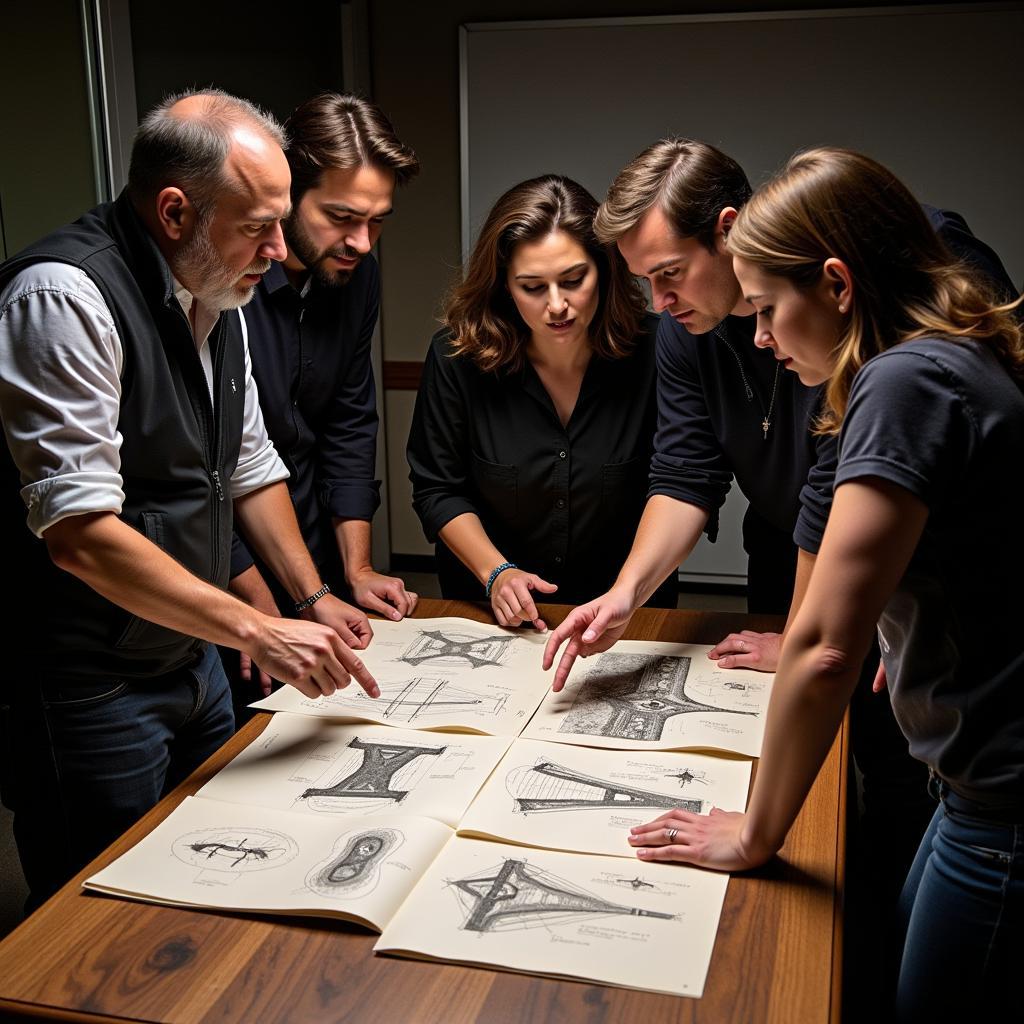Research Drawing plays a crucial role in the world of paranormal research, acting as a bridge between the seen and unseen, the tangible and the intangible. It involves individuals, often with no prior artistic skill, producing sketches based on intuitive impressions, sensory experiences, or even purported communication from the ethereal realm. But what exactly is the significance of these drawings, and how do they contribute to the broader field of paranormal research?
 Research Drawing in Paranormal Investigation
Research Drawing in Paranormal Investigation
Delving Deeper: The Mechanics of Research Drawing
The process typically begins with investigators creating a calm and focused environment conducive to receptivity. This might involve dimming the lights, using meditation techniques, or employing sensory deprivation tools. Participants, sometimes referred to as “sensitive artists,” then allow their subconscious to guide their hand, translating unseen energies or impressions into visual representations.
These drawings can vary widely in style and content, ranging from abstract shapes and patterns to detailed depictions of entities or scenes. Some researchers believe that these images might capture glimpses of the spirit world, residual energy, or even the subconscious minds of the individuals present.
Analyzing the Evidence: Interpretation and Significance
Interpreting research drawings is undoubtedly subjective, relying heavily on the context of the investigation and the experiences of those involved. However, certain patterns and recurring motifs have been observed, leading to some intriguing theories.
For instance, recurring symbols like spirals, vortexes, or specific geometric shapes might suggest the presence of energetic portals or interdimensional gateways. Likewise, detailed drawings of unknown individuals, particularly if corroborated by other paranormal evidence, could provide clues about the history or nature of a haunting.
 Paranormal Research: Analyzing Drawings
Paranormal Research: Analyzing Drawings
The Importance of Skepticism and Critical Analysis
While research drawing can be a compelling aspect of paranormal research, it’s essential to approach it with a healthy dose of skepticism and critical thinking. Just as with any other form of evidence, corroboration from other sources is crucial.
External factors, such as the power of suggestion, pre-existing beliefs, or even unintentional cues from investigators, can influence the outcome of a research drawing session. Therefore, maintaining rigorous protocols, documenting the process thoroughly, and considering alternative explanations are paramount.
Applications Beyond the Veil: Research Drawing in Other Fields
Interestingly, the concept of using drawing as a tool for accessing subconscious or unseen realms isn’t limited to paranormal research. It finds resonance in fields like art therapy, dream analysis, and even forensic science, where sketch artists rely on eyewitness accounts to create portraits of potential suspects.
how to design and evaluate research in education
This overlap highlights the potential of research drawing to tap into hidden layers of perception and understanding, regardless of the specific field of application.
Research Drawing: A Window to the Unknown?
While research drawing may not offer definitive answers, it undoubtedly adds another layer of intrigue to the already enigmatic world of paranormal research. It underscores the power of the human mind to perceive beyond the conventional senses and offers a glimpse into the vast, unexplored territories of consciousness and reality.
As we continue to refine our methods and explore the potential of research drawing, we may yet unlock profound insights into the mysteries that lie beyond our current understanding.
Frequently Asked Questions About Research Drawing
1. Can anyone do research drawing, or do you need special abilities?
While some individuals may be more naturally inclined towards intuitive experiences, anyone can engage in research drawing. The key is to approach it with an open mind and a willingness to explore the unknown.
2. What if I’m not a good artist? Does it matter?
Artistic skill is not a prerequisite for research drawing. The focus is on capturing impressions and translating them onto paper, regardless of artistic merit.
3. Are research drawings considered scientific evidence?
Due to their subjective nature, research drawings are not typically considered conclusive scientific evidence. However, they can provide valuable insights and contribute to a more comprehensive understanding of a paranormal event when considered alongside other forms of evidence.
4. Can research drawing be used to contact specific spirits?
While some practitioners believe it’s possible to connect with specific entities through research drawing, it’s essential to approach such endeavors with caution and respect. It’s crucial to remember that we are dealing with the unknown, and unintentional consequences are always a possibility.
5. What are some of the limitations of research drawing?
Research drawing is inherently subjective and open to interpretation. External factors, such as suggestion or personal biases, can also influence the process. Therefore, it’s crucial to maintain a critical perspective and consider alternative explanations.
Need More Answers?
If you’re eager to explore the world of Paranormal Research further, check out these related articles:
- master ball research 2024
- great lakes research center
- difference between an essay and a research paper
Don’t hesitate to contact us if you need expert assistance with your paranormal investigations. Our team is available 24/7 to answer your questions and provide guidance.
Contact Information:
Phone Number: 0904826292
Email: research@gmail.com
Address: No. 31, Alley 142/7, P. Phú Viên, Bồ Đề, Long Biên, Hà Nội, Việt Nam.